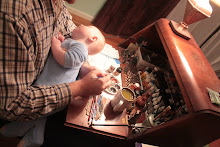Yesterday I submitted my entry in to the Roman adventure contest being run by Ramblings of Great Khan, even though the deadline was extended to cover the weekend. My entry ended up being six pages in length, and had four maps, a number of random tables, and a bit of information about the Roman world. Indeed, one of the nice things about writing an adventure for the Roman world is how much we know about it. There are a large number of writings from the period which have survived, and combined with archaeological research, we have a general picture of life in the Empire (although there are still plenty of knowledge gaps and new things to discover).
Here are some resources to help a Roman campaign:
Sea Power:
Although Rome was never a "naval nation" in the sense of Athens, Carthage, or England, the Roman navy was important to the Republic and Empire, as it prevented piracy, and was used to move the army around Mare Nostrum. Like most navies, figuring out the exact composition of forces is difficult, as they used the names of specific ship types for entirely different later classes of ships. (Much like the destroyer or frigate in a modern navy). Ship types changed little from hellenistic era ships, but they did mount more and heavier artillery. Happily there is also a game for fighting out naval combat.
Land Power:
Everyone is familiar with the Roman Legion, an unstoppable force of red shielded jack-sandled thugs fighting barbarians all over the frontier. Who would not want to play them? Possibly someone familiar with the 25 year enlistment period! Aside from the familiar legions, Rome also had auxiliaries to supply cavalry, archers, slingers, and extra infantry.
Maps and Travel:
Due to the hard work of some folks at Stanford, we have a handy travel calculator called Orbis, which allows for calculating the cost, duration, and route between two points in the Empire. So if one wanted a party to travel from Londinium to Rome itself, in January, you can do that, with a variety of options to prioritize land vs sea travel etc. (and we find it takes 30.8 days and would cost over 1600 denarii). There is a similar program called Omnes Viae that includes destinations outside of the Roman world, such as India. And if you like Google maps (and who does not?) there is a similar program for the ancient world called Pelagios, and another called Vici that shows all the known Roman artifacts and influences in an area (and you can even overlay it on the Pelagios map).
Gladiators:
People who fought beasts and each other to the death for the amusement of crowds... what is not to like? (in a fictional D&D setting) Different types of traditional gear were used, and gladiators were assigned roles based on the gear they used.
Cults/secret societies:
Rome was awash in weird cults in the Imperial period, like the cults of Dionysus, Isis, Mithrandis, Jesus, and more. The authorities would periodically crack down on them, and religious fervor was the cause of plenty of revolts and revolutions. Lots of scope here for eastern magi cults, spy intrigue and other actions between minor groups.
Miniatures:
Rome has long been popular with wargamers, and as such there are miniatures for Rome and its primary enemies in every scale, from 2mm-54mm, so if you want to do big battles or detailed skirmishes, you can. Wargames Foundry has figures for Punic war republic, Late republic, Early, and Late empire, as well as a horde of useful greek figures, and various barbarian types. Wargames Factory makes plastic figures for a Caesarian period, and Warlord Games makes plastic figures for early Imperial battles, and also publishes Hail Caesar! There are lots of options for Gladiator miniatures, in pretty much all of the larger scales.
The Romans even had a mechanical calculator, and could have had steam engines.
There are plenty of resources for Roman play and campaigns. So get out there!
Friday, February 1, 2013
Subscribe to:
Post Comments (Atom)



No comments:
Post a Comment